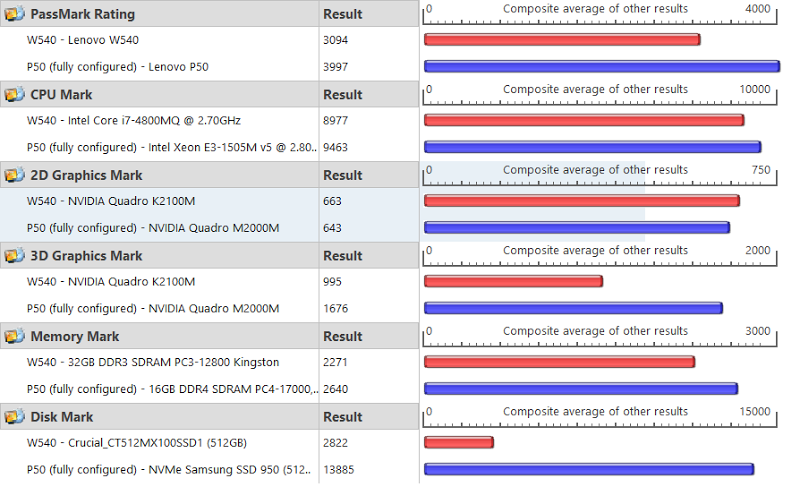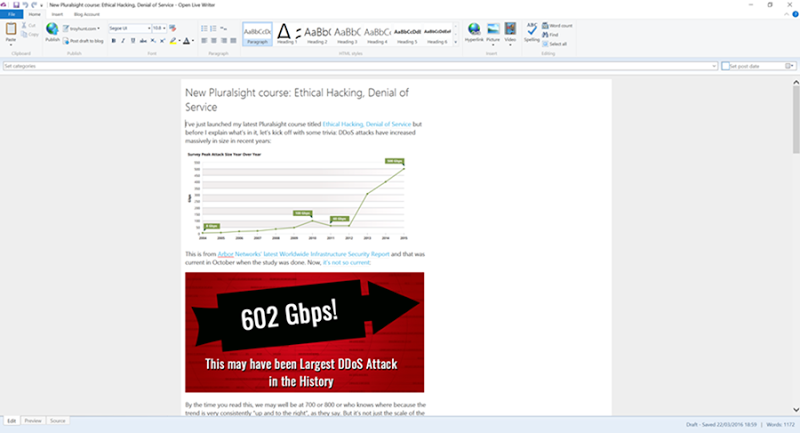A little while back, I wrote about how Lenovo were sending me some things as part of their Insiders program which meant getting to use a number of machines I probably wouldn’t have thought twice about otherwise. The Yoga 900 in that blog post, for example, is not something I would have normally considered for myself as I like a physically larger, gruntier machine yet it’s turned out to be one of the best laptops I’ve ever owned. You’d normally find me with a machine like a W540 which is the last machine I bought myself about 18 months back and it’s been sensational… until this arrived:
There we go - my new new workhorse - a P50! pic.twitter.com/oCzuQELpYE
— Troy Hunt (@troyhunt) February 26, 2016
In total honesty, had it been my own dollars I wouldn’t have gone out and bought the P50 because the W540 is still such a good machine. I want to be transparent about that because the last thing I want is a perception of my views being skewed by virtue of getting free stuff from Lenovo.
In terms of why they feel compelled to send me things, well, it’s because of stuff like this:
I just got a Lenovo P50 because @troyhunt made it sound sooooo cool
— MomMeetCoffee (@mommeetcoffee) March 18, 2016
Obviously influence is important to them particularly when it’s viewed as being objective, independent thoughts. So with that in mind, let me share how I’ve been finding the machine and I’m going to give you a bunch of stats followed by what I didn’t initially like and then why I decided I did like it!
It’s not for lightweights…
Let’s be clear about who this class of machine is for. Actually, I’ll turn it around – here’s who it’s not for:
@mommeetcoffee @troyhunt looks nice and...heavy. Do you guys dead lift with it? :P
— Steven Luu (@sluu99) April 6, 2016
The machine weighs in at somewhere between 2.5 and 3kg depending on how you configure it then you can add another 0.7kg for the seriously chunky power brick. My Yoga 900, by comparison, is only 1.3kg and the power supply probably just a couple of hundred grams. If the weight worries you, this is not the machine for you. For me personally, I do a lot of travel with a large machine and the Yoga all in my backpack and it doesn’t bother me, but maybe that’s just me.
The P50 isn’t intended to be a lightweight machine. It’s got a 15.6” screen so to begin with it’s a bigger chassis than many of today’s lightweight machines, then there’s the fact that it has a Xeon processor. Yep, Xeon. This machine is the world’s first laptop to use the Skylake microarchitecture and I can only imagine that it means a fair bit of cooling is also required hence the sizable fan ports on the thing. Ports is the other thing – 4 USB 3.0, a USB Type C, Ethernet, HDMI, mini display port, express card, smart card reader – it all adds up to more weight.
Look, I really like carrying the Yoga to a coffee shop or using it on the plane, but I really like working with a larger keyboard with more travel on the keys and using a large screen. But more than all that, I like power. Lots of power. Let’s see how much.
Benchmarks
Let’s just get straight to the numbers; here’s my PassMark PerformanceTest results for the old W540 and the new P50:

Other than the very slight dip on 2D graphics, the P50 is quicker across the board but it’s the disk that really smashes it. When Lenovo shipped the machine to me, it came with a 256GB NVMe SSD which isn’t quite big enough for a primary drive these days. I went and bought a 512GB Samsung 950 Pro NVMe which appears to be widely accepted as about the faster drive you can get and oh boy – look at the rating on that sucker! That’s compared to the Crucial SSD in the old W540, but I saw similar improvements comparing it against other machines I’d had with older SSDs. (Incidentally, you’re reading this whilst struggling to get a Lenovo P50 or P70 booting from this drive, read this.)
In terms of the other specs, you can read the whole machine configuration in this system overview from PerformanceTest. Lenovo sent it to me with 16GB of DDR4 ECC RAM which I probably would have specced at 32 had I the choice (I’ve already run short whilst running a VM). The machine will actually go up to 64 which is pretty nuts for a laptop but if you’re doing anything memory intensive then that would be neat. I’ll likely just order some more shortly.
What’s also interesting is Greg Pakes recently picked up a Dell XPS 9550 and asked to compare baselines. We did a swap and here’s the end result:

The Lenovo was faster in every area, even with the disk which is an identical drive in each so I can only assume it’s related to bus architecture on the machine or something else specific to the P50’s design. That said, do be conscious that all of these benchmarks can fluctuate between runs, particularly depending on what’s running on the machine at the time and which drivers are installed.
For the curious, if you’d like a copy of my benchmark you can grab it here. Note that the “fully configured” suffix indicates that this was after I configured everything optimally. Also note that it was before configuring Bitlocker so I expect there’d be a bit of a perf hit there. In short, this is the best result I could get out of the machine.
High DPI displays – we’re not quite ready
I’m notorious for wanting the latest shiny thing. There’s something in my head that just automatically associates “newer” with “better” and that carries with it this innate desire to upgrade and reap the benefits, whether they be perceived or real.
One such example is higher DPI devices and my love of lots more pixels in ever smaller spaces started with the iPhone 4. It was so… dense! So of course I later on had to have the iPad with lots of pixels and they are indeed beautiful devices. More recently, that’s extended to PCs and the Lenovo W540 I purchased about 18 months ago. Lovely machine, heaps of grunt and it’ll happily do 2,880x1620. More recently, I received a Yoga 900 at 3200x1800 and that’s in a smaller screen that the W540 too so it’s dense pixels FTW.
When the P50 arrived, I was initially disappointed when I saw it only did 1080p. That’s less than half the pixels than the old 540 therefore it is worse, right? No, and here’s why:
I spend a huge amount of time working in Camtasia where I edit my Pluralsight courses. Here’s what it looks like on the new P50:

And now on the W540 with the higher DPI:

The canvas no longer stretches to the edges when told to “Shrink to fit”, the buttons all become smaller than they should and various other dialogues have clearly odd spacing, particularly for someone like me who gets pedantic about these things. For an app I spend huge amounts of time in, this is enormously frustrating.
Let’s try LiveWriter where I write my blogs. Here’s the P50 at 1080p:

And now here’s the W540 with the higher DPI:

There’s no concept of scaling the pixels on the higher DPI machine to align with the size the browser will render it at once it’s published. If you’ve ever seen me post a blog with oddly sized images it’s usually because I wrote it on the W540 and what I was seeing at design time is not what I ended up getting at publish time.
There are many, many other apps that struggle too. SQL Server Management Studio has various quirks, as do Red Gate’s tools that I run within them. It gets worse as the DPI goes up too – it’s much more obvious when I use the Yoga 900 with 3,200 horizontal pixels versus the W540 with 2,880 compared with the P50 at “only” 1,920.
Let us be clear – this is the software’s fault not the machine’s – but it’s software I’m heavily dependent on. It’s not just the apps I install on the machine either, Windows 10 itself seems to struggle with the DPI namely when changing resolutions. Often I’ll see some assets appear to be targeting one pixel density and others targeting another; desktop icons suddenly become too small or the taskbar too big or any number of things that remind you how the high DPI model is still a second class citizen.
It pains me to say it because I want that pixel density so that I have super sharp visuals, but if I’m honest, I haven’t missed it at all with the P50. Like I said, a 1080p screen would not have been my first choice but having these apps that haven’t got with the times yet behave as they should and not having dramas with Windows flicking between pixel densities has been rather nice! Hopefully by the next time I come to need a new machine things will be more stable but for now, less is actually more.
What’s it like to use the P50?
So keeping in mind that this is a combination of how I find it compared to the W540 and general observations about the machine itself, there’s a few things that stick out.
Firstly, it has proper buttons next to the trackpad:

The W540 had one of those pushable trackpads which initially drove me nuts then I got kinda used to. Now I’m readjusting again but I think this is a better design, if for no other reason than it’s more tactile and there’s a clearer delineation of where each button is. I normally use a wireless external mouse anyway though so it’s infrequent I touch the pad.
Fingerprint reader – get one. The last machine had one too although the P50’s implementation just involves placing the finger on it versus swiping it like on the old machine. The best bit about a fingerprint reader is not the ease of logging back in (although that’s nice), it’s being able to do it in front of other people without that awkward thing where they try to look away and you try to hide what you’re doing. I love Touch ID on my iThings for the same reason.
The fan – why does it keep coming on?! I don’t know why, but even on normal power setting and sitting there doing nothing it wants to spin it up every now and then. The old machine didn’t do this, perhaps it’s something I need to probe into a bit further.
Malware – no, I haven’t found any! I say this simply as I pretty much have a new metric when I tweet anything Lenovo related these days which is TTFS, otherwise known as Time To First Superfish. Lenovo screwed up badly on this front last year and they know it. I usually repave the machine from scratch anyway so anything on the disk is clean (plus it’s a new disk too), so short of funky firmware or BIOS software (and yes, I’m aware of the history there too), it’s all good.
Keyboard – I mentioned it earlier but it has a much more tactile feel than something like the Yoga. I know Apple rant on about how much effort goes into the way the keys on the Macbook feel when they’re pressed but they’re actually right – a good keyboard feels nice to use. I like the concave on the keys, the smooth but not glossy surface and the spacing between each one. It’s just a good place to spend lots of time and that’s exactly what a workhorse laptop should feel like IMHO.
This is really just a casual “here’s how I find it” review, if you want to get really into depth, check out this review on the ThinkScopes blog.
Cheap productivity
I love the saying that computers are cheap and humans are expensive. Comparatively little costs in hardware can translate to big savings in productivity and as the value of your time increases, the statement becomes truer. It’s a hard thing to quantify though; if you spend $1k more on a top-spec machine, what’s the ROI? I’ve got no idea but I do know that very small gains will easily justify a dollar a day over the (likely) life of the machine and I also know that in terms of buying productivity, $1 is nothing.
It always infuriated me back in my corporate life at Pfizer how cost was viewed when it came to people and productivity. The thing that really stuck in my mind is that during an organisation-wide refresh of machines there was a push to keep the primary HDD at only 128GB which made things very tight on space. It was something like $100 to increase the capacity to a level where it would be plenty for the vast majority of people but the argument was always “Do you know how much it would cost to do that across X number of people?!” because that was the big scary figure. My retorts of “Do you know how much we’re paying those X number of people?!” generally didn’t go down too well even though it meant valuable resources wasting time purging otherwise useful files because hey, that upfront cost looks scary! Use your common sense on these things and invest in equipment that will help you do your job and above all, that you actually enjoy using.
But I digress, the point is that whenever it’s me paying the money, I always err on the side of going fast and being productive and this machine is pretty much the epitome of that.
Summary
The capability of the machine is kinda the point in terms of wearing the additional weight; this machine will do pretty much everything my usual desktop machine will do. I travel a lot and I want to be just as capable on the other side of the world or at 30,000 feet as I am when I’m sitting at home (lack of multiple monitors aside). I travel with both this machine and my Yoga in part because I always have a backup machine when I’m speaking and in part because when I’m running workshops I tend to present from one machine then use another to prepare things whilst the class is doing their exercises. For me, capability is more important than weight and if your priorities are inversed then this is not the laptop you’re looking for.
But if going fast in a fully-featured machine is your priority then this is absolutely the machine I would buy with my own cash, albeit with 32GB of RAM… and a higher DPI screen which I would then curse at!